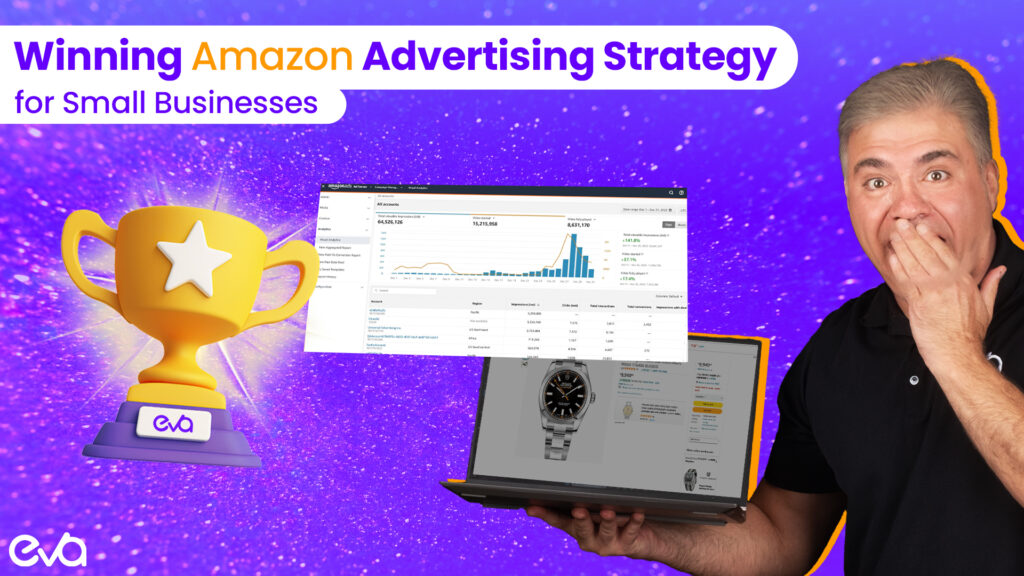Table of Contents
- Introduction
- Why is Amazon Advertising Important for Small Businesses?
- The Potential Impact of Amazon Small Business Advertising on Growth
- Benefits of Amazon Small Business Advertising
- Understanding Amazon Ad Types and Formats
- Setting SMART Goals for Your Amazon Small Business Advertising Campaign
- How to Win the Amazon Buy Box
- Calculating and Optimizing Your Advertising Cost of Sale (ACoS)
- Conducting Keyword Research for Amazon Small Business Advertising
- Encouraging Customer Reviews and Managing Feedback
- Step-by-Step Guide to Setting Up an Amazon Small Business Advertising Campaign
- Advanced Targeting and Optimization Strategies
- Measuring Success: Key Metrics and Analytics for Amazon Small Business Advertising
- How Eva Can Help You Maximize ROI with Amazon Small Business Advertising
- FAQs
- Conclusion
Introduction
Amazon small business advertising has rapidly become a crucial strategy for entrepreneurs looking to expand their reach and increase sales.
In today’s competitive online marketplace, small businesses must leverage every tool at their disposal to stand out, and Amazon’s advertising platform provides a powerful means to do so.
By utilizing Amazon’s vast network, small businesses can not only enhance their product visibility but also reach a global audience that was once out of reach.
This blog will explore the significance of Amazon small business advertising, its many benefits, and how to create a successful advertising strategy that drives sustainable growth.
Why is Amazon Advertising Important for Small Businesses?
Amazon small business advertising is essential because it allows small businesses to tap into a market that might otherwise be dominated by larger brands.
With Amazon’s advanced targeting options, even businesses with modest budgets can ensure that their ads reach the most relevant potential customers.
This targeted approach means that ad spend is used more efficiently, leading to higher returns on investment.
Moreover, Amazon’s platform provides detailed analytics, allowing businesses to monitor and optimize their campaigns in real-time, making Amazon small business advertising not just accessible but also highly effective.
Key Statistics:
- Amazon controls nearly 50% of the U.S. e-commerce market, a testament to its dominance in online retail and the potential it holds for advertisers.
- Amazon’s ad revenue surpassed $40 billion in 2023, underscoring the growing reliance on Amazon small business advertising as a key driver of sales.
The Potential Impact of Amazon Small Business Advertising on Growth
Amazon small business advertising has the potential to significantly alter the growth trajectory of a business.
By expanding customer reach, improving product discoverability, and boosting sales, Amazon’s advertising platform can help small businesses achieve milestones that would have been difficult through traditional marketing methods alone.
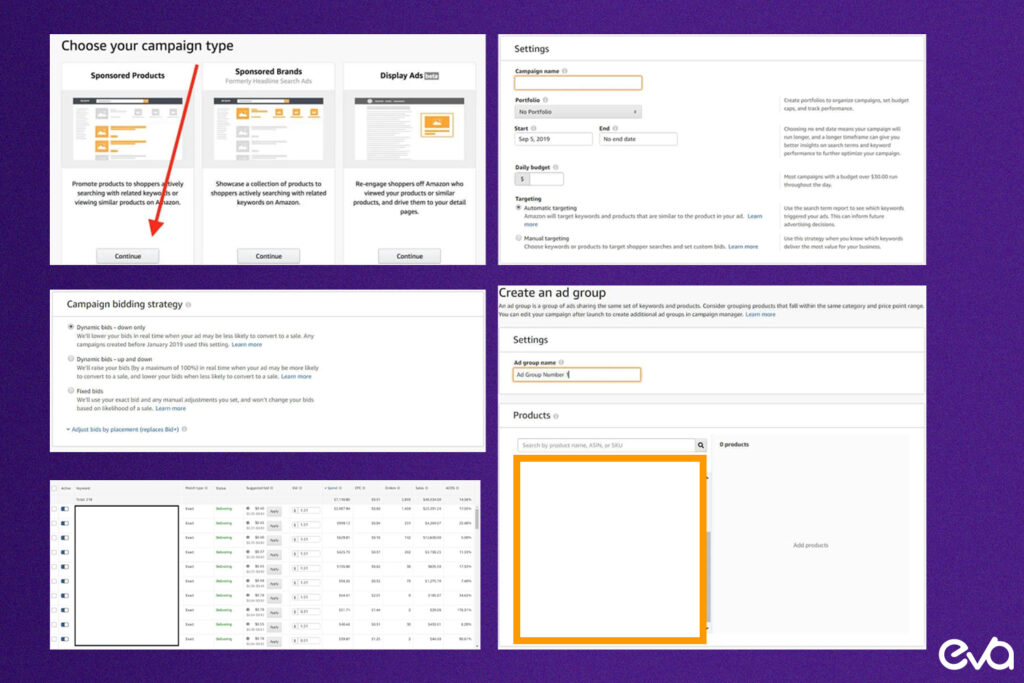
Expanded Customer Reach
One of the most immediate benefits of Amazon small business advertising is the ability to reach a much larger audience than through other channels.
Amazon’s global presence means that a small business in one part of the world can reach customers in another, effectively expanding its market reach without the need for a physical presence in multiple locations.
For instance, a small coffee brand that utilized Amazon’s Sponsored Products ads saw a 200% increase in traffic to its product pages, leading to a substantial boost in sales.
This level of reach and impact is difficult to achieve through traditional advertising methods, making Amazon small business advertising a game-changer for businesses looking to scale.
Improved Product Discoverability
In a marketplace as crowded as Amazon, product discoverability can make or break a business. Amazon small business advertising enhances the visibility of products that might otherwise get lost among the millions of listings on the platform.
By using targeted keywords and placing ads in strategic locations, businesses can ensure that their products are seen by customers who are already interested in similar items.
Effective Amazon small business advertising involves not just placing ads but also optimizing product listings with high-quality images, detailed descriptions, and accurate categorization, all of which contribute to making a product more discoverable and, therefore, more likely to sell.
Enhanced Brand Authority
Building brand authority is another critical benefit of Amazon small business advertising. For small businesses, establishing credibility in the eyes of potential customers is crucial, especially when competing against well-established brands.
Amazon’s advertising tools, such as Sponsored Brands ads, allow businesses to consistently appear in search results and product listings, reinforcing their presence and authority within their niche. Over time, this visibility helps build trust with consumers, making them more likely to choose your brand over competitors.
By investing in Amazon small business advertising, small businesses can effectively compete with larger brands and carve out a significant share of the market.
Optimized Sales Performance
Advertising on Amazon directly correlates with increased sales performance, especially when ads are strategically targeted and optimized.
Amazon small business advertising enables businesses to place their products in front of the right customers at the right time, leading to higher conversion rates and more sales.
For example, a small electronics company that strategically used Amazon’s Sponsored Products ads saw a 150% increase in sales within a few months.
This demonstrates the direct impact that well-executed Amazon small business advertising can have on a company’s bottom line, turning ad spend into a powerful revenue-generating tool.
Benefits of Amazon Small Business Advertising
The benefits of Amazon small business advertising extend far beyond just reaching a larger audience. This advertising method offers a range of advantages, including increased sales, enhanced brand visibility, and the ability to compete effectively with larger companies.
Reaching a Larger Audience
One of the most compelling benefits of Amazon small business advertising is its ability to reach a global audience.
Amazon’s platform breaks down geographical barriers, allowing small businesses to extend their reach far beyond their local markets.
By advertising on Amazon, a business can reach millions of potential customers across different countries and regions, something that would be incredibly difficult and costly through other means.
This extended reach not only increases the potential customer base but also diversifies the business’s revenue streams, reducing reliance on local markets and increasing overall business stability.
Infographic Idea: A world map could be used to highlight Amazon’s global reach, showing key customer demographics and regions where Amazon small business advertising has been most effective.
This visual representation would underscore the extensive audience that small businesses can access through Amazon.
Increasing Sales
At its core, Amazon small business advertising is designed to drive sales. By placing products in front of customers who are already in a buying mindset, Amazon ads are particularly effective at converting clicks into purchases.
Tools like Amazon Attribution and Campaign Manager allow businesses to track the performance of their ads in real-time, providing insights that can be used to fine-tune campaigns for even better results.
This data-driven approach ensures that ad spend is used efficiently, maximizing the return on investment and driving sustained sales growth.
Enhancing Brand Visibility
In today’s crowded marketplace, brand visibility is crucial for success, and Amazon small business advertising is an excellent tool for enhancing it.
Through Sponsored Brands ads and Amazon Storefronts, small businesses can create a strong brand presence on the platform.
These tools allow businesses to showcase their brand story, highlight key products, and engage customers in a way that goes beyond simple product listings.
By consistently appearing in front of potential customers, Amazon small business advertising helps build brand recognition and trust, which are essential for long-term business success.
Understanding Amazon Ad Types and Formats
Amazon offers a variety of ad types and formats, each designed to meet different marketing objectives. Understanding these options is key to maximizing the effectiveness of Amazon small business advertising.
Sponsored Products
Sponsored Products are the backbone of Amazon small business advertising. These pay-per-click (PPC) ads promote individual product listings within search results and on product detail pages.
They are particularly effective for driving traffic directly to your product pages, making them an ideal choice for small businesses looking to increase sales.
Sponsored Products ads are easy to set up and allow businesses to target specific keywords, ensuring that their ads are seen by customers who are already searching for similar products.
This targeted approach increases the likelihood of conversion, making Sponsored Products a vital component of any Amazon small business advertising strategy.
Sponsored Brands (Headline Search Ads)
Sponsored Brands, also known as Headline Search Ads, allow businesses to showcase their brand logo, a custom headline, and up to three products in a prominent position at the top of search results.
This ad format is particularly effective for enhancing brand visibility and driving traffic to your Amazon Store or a custom landing page.
Amazon small business advertising that leverages Sponsored Brands ads can significantly increase brand awareness, as these ads are among the first things customers see when they search for related products.
The ability to feature multiple products and craft a compelling headline makes Sponsored Brands a powerful tool for telling your brand’s story and capturing customer attention.
Sponsored Display (Product Display Ads)
Sponsored Display ads are designed to retarget customers both on and off Amazon, making them a powerful tool for reaching shoppers who have shown interest in your products but haven’t yet made a purchase.
These ads can appear on Amazon’s product detail pages, customer review pages, and across the web on third-party sites.
Amazon small business advertising that includes Sponsored Display ads can help keep your products top of mind for potential customers, increasing the chances of conversion.
By targeting customers who have already engaged with your brand, Sponsored Display ads provide a second chance to convert interest into a sale.
Video Ads
Amazon Video Ads offer a dynamic way to engage customers and stand out in the crowded marketplace. These ads appear across Amazon’s site, including on product detail pages, search results, and on Amazon devices like Fire TV.
Amazon small business advertising that includes video ads can capture customer attention quickly with engaging content that highlights your product’s features and benefits.
Video ads are particularly effective for demonstrating how a product works, showcasing customer testimonials, or telling a compelling brand story.
The versatility and wide reach of video ads make them an invaluable addition to any Amazon small business advertising strategy.
Custom Ads
Custom Ads on Amazon offer businesses the flexibility to create bespoke ad experiences tailored to specific campaign goals.
These ads can include unique creatives, placements, and formats, allowing small businesses to develop highly targeted campaigns that stand out.
Amazon small business advertising that leverages Custom Ads can take advantage of innovative formats and cross-channel integration, ensuring that your brand’s message is delivered in the most impactful way possible.
Whether you’re launching a new product, running a seasonal promotion, or building brand awareness, Custom Ads provide the creative freedom to craft an advertising experience that resonates with your target audience.
Setting SMART Goals for Your Amazon Small Business Advertising Campaign
Setting SMART goals—Specific, Measurable, Achievable, Relevant, and Time-bound—is essential for guiding your Amazon small business advertising strategy and ensuring success.
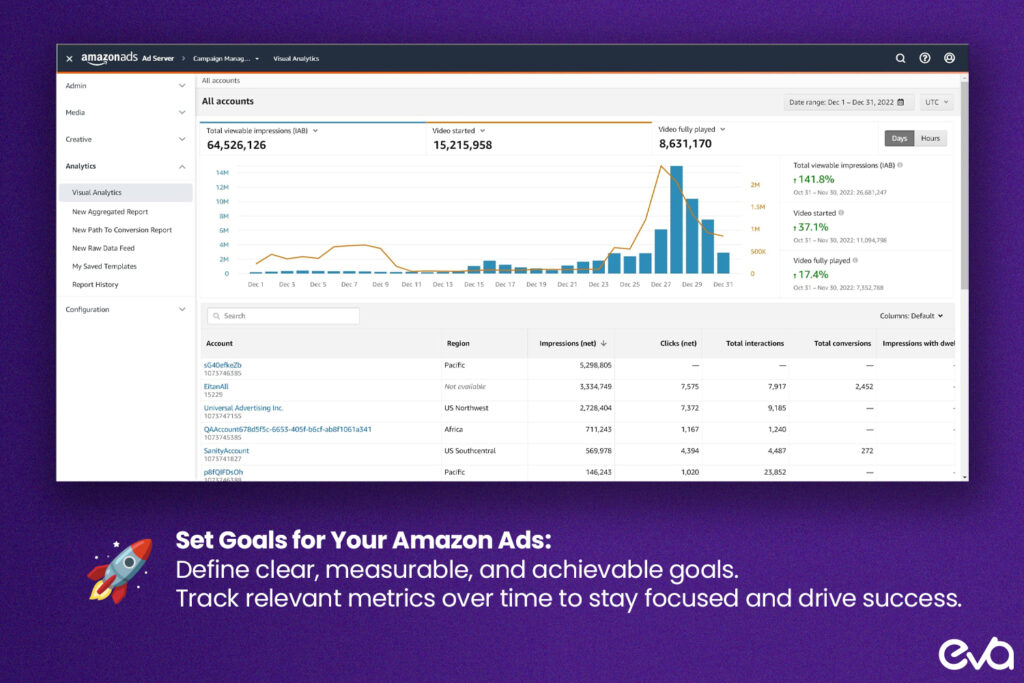
What are SMART Goals?
SMART goals provide a clear and structured approach to setting objectives that can guide your Amazon small business advertising campaigns.
By being specific, these goals ensure that everyone on your team understands what needs to be achieved.
Measurable goals allow you to track progress and make necessary adjustments, while achievable goals keep expectations realistic and within reach.
Relevant goals ensure that your Amazon small business advertising efforts are aligned with broader business objectives, and time-bound goals create a sense of urgency, motivating your team to stay on track and meet deadlines.
Examples of SMART Goals for Amazon Small Business Advertising
- Earning 30 Reviews for a Product Within Six Months: This goal is specific (30 reviews), measurable (tracked over six months), achievable (based on past customer feedback trends), relevant (customer reviews are crucial for product success on Amazon), and time-bound (within six months). By setting such goals, your Amazon small business advertising strategy can focus on enhancing customer engagement and building product credibility.
- Increasing Sales by 15% in Three Months: This goal is specific (15% sales increase), measurable (compared to the previous quarter’s sales), achievable (given market trends and current campaign performance), relevant (aligns with revenue growth objectives), and time-bound (three months). Setting this goal ensures that your Amazon small business advertising is geared towards driving immediate, tangible results.
- Reducing Inventory by 100% Before Launching a New Product: This goal is specific (complete inventory reduction), measurable (inventory levels tracked over time), achievable (based on sales trends), relevant (necessary for clearing space for new products), and time-bound (before the new product launch). By focusing on inventory reduction through targeted Amazon small business advertising, you can streamline operations and prepare for the next phase of business growth.
How to Win the Amazon Buy Box
Winning the Amazon Buy Box is crucial for maximizing sales, as the majority of purchases on Amazon are made through this feature.
Amazon small business advertising plays a vital role in positioning your products to win the Buy Box.
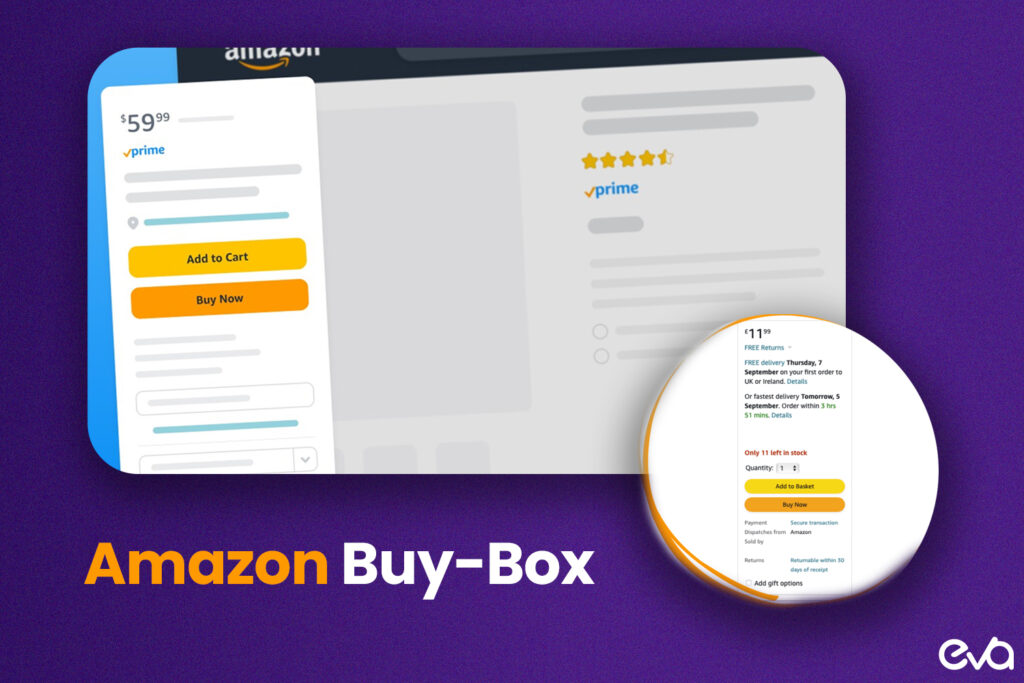
Understanding the Amazon Buy Box
The Amazon Buy Box is essentially the box on a product detail page where customers can directly add items to their cart or make a purchase.
Winning the Buy Box can significantly boost your sales because it means that your product is the one Amazon recommends as the best offer.
This is particularly important for products that have multiple sellers, as only one seller can “win” the Buy Box at any given time.
Amazon small business advertising can help you achieve the competitive pricing, fulfillment efficiency, and high seller performance metrics necessary to win the Buy Box.
Key Factors That Influence Buy Box Eligibility
- Pricing: Competitive pricing is one of the most important factors in winning the Buy Box. Amazon small business advertising can help you attract more sales, allowing you to maintain lower prices while still being profitable.
- Fulfillment Method: Sellers using Fulfillment by Amazon (FBA) or Seller Fulfilled Prime (SFP) are more likely to win the Buy Box. These fulfillment methods ensure fast, reliable shipping, which Amazon values highly. Amazon small business advertising can drive more traffic to your listings, increasing your chances of securing these fulfillment options.
- Order Defect Rate (ODR): This metric includes negative feedback, A-to-Z Guarantee claims, and chargeback rates. A lower ODR increases your chances of winning the Buy Box. By leveraging Amazon small business advertising to boost positive reviews and customer satisfaction, you can keep your ODR low.
- Shipping Time: Faster shipping times improve your chances of winning the Buy Box. Amazon small business advertising can help you increase sales volume, justifying investments in faster shipping options.
- Seller Performance Metrics: Metrics such as customer feedback, order defect rate, late shipment rate, and response time to customer inquiries all play a role in Buy Box eligibility. Amazon small business advertising can help you maintain high performance by driving more sales and encouraging positive customer interactions.
Strategies to Win the Buy Box
Winning the Buy Box requires a combination of strategic pricing, exceptional customer service, and optimal fulfillment practices.
Amazon small business advertising can be a powerful tool in helping you achieve these goals.
- Pricing Strategies to Remain Competitive: Use dynamic pricing tools to automatically adjust your prices based on competitor activity, ensuring that your offer remains competitive without constantly monitoring prices manually. By driving more traffic and sales through Amazon small business advertising, you can afford to price competitively while maintaining profitability.
- Maintaining Stock Levels and Shipping Speed: Keep a close eye on inventory levels to avoid running out of stock, which can cause you to lose the Buy Box. Use inventory management tools to predict demand and ensure you always have enough stock. Amazon small business advertising can help increase demand, justifying investments in better inventory management and faster shipping methods.
- Optimizing Seller Performance Metrics: Focus on customer service excellence, such as responding to customer inquiries promptly, resolving issues quickly, and aiming for high customer satisfaction. Positive feedback directly influences your Buy Box eligibility, and Amazon small business advertising can drive more interactions that help boost these metrics.
Calculating and Optimizing Your Advertising Cost of Sale (ACoS)
Advertising Cost of Sale (ACoS) is a crucial metric for evaluating the effectiveness of your Amazon small business advertising campaigns.
It represents the ratio of your ad spend to the revenue generated from those ads, and understanding how to calculate and optimize ACoS is essential for ensuring that your advertising efforts are both effective and profitable.
Understanding ACoS
ACoS, or Advertising Cost of Sale, is calculated using the following formula:
For example, if you spend $100 on ads and generate $500 in sales from those ads, your ACoS would be 20%.
This means that 20% of your sales revenue is being spent on advertising. A lower ACoS generally indicates a more efficient Amazon small business advertising campaign, where less of your revenue is consumed by ad costs.
However, the ideal ACoS varies depending on your profit margins, business goals, and the specific products you are advertising.
Optimizing ACoS
Optimizing ACoS involves reducing your ad spend relative to the sales it generates, without compromising the effectiveness of your campaigns. Here are some strategies to achieve this:
- Keyword Optimization: Focus on high-performing keywords that generate the most sales at the lowest cost. Identify and target these keywords in your Amazon small business advertising campaigns while using negative keywords to exclude irrelevant search terms that are not converting, thereby reducing wasted ad spend.
- Bid Management: Adjust bids based on keyword performance. For keywords with a high ACoS, consider lowering your bids to reduce costs while still maintaining visibility. Amazon small business advertising platforms offer automated bidding tools that adjust bids in real-time based on performance, ensuring that you are not overspending on underperforming keywords.
- Ad Placement Optimization: Some ad placements may have a lower ACoS than others. For instance, ads appearing in the “Sponsored Products” section might have a lower ACoS than those in other areas. Continuously test different placements to find the most cost-effective options in your Amazon small business advertising strategy.
- Improve Conversion Rates: Higher conversion rates lead to lower ACoS because more of the traffic driven by your ads turns into sales. Enhance your product listings by using high-quality images, detailed descriptions, and compelling bullet points to persuade potential buyers. Conduct A/B testing on ad creatives to see which versions resonate most with your audience and drive higher conversion rates, thereby optimizing your Amazon small business advertising efforts.
Conducting Keyword Research for Amazon Small Business Advertising
Keyword research is the backbone of any successful Amazon small business advertising campaign. It involves identifying the terms and phrases that potential customers use to search for products like yours.
By effectively targeting these keywords, you can increase your product’s visibility, drive more traffic to your listings, and ultimately boost sales.
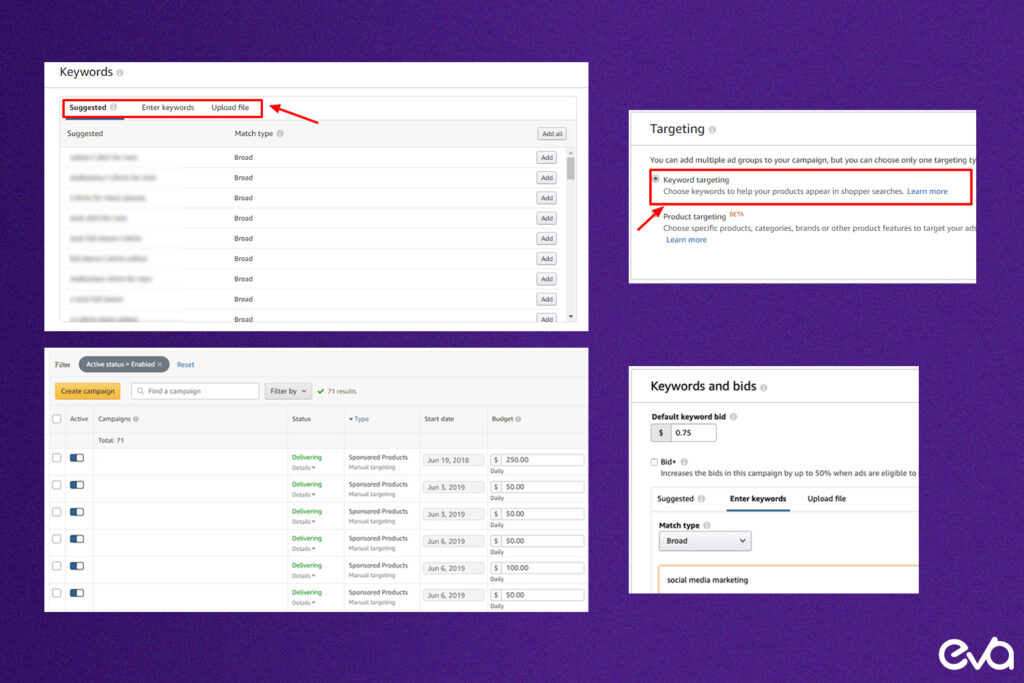
Importance of Keyword Research
Effective keyword research is crucial because it ensures that your ads appear in front of the right audience.
The more relevant your keywords are to the search terms your potential customers use, the higher the chances that they will see your ads and make a purchase.
For Amazon small business advertising, keyword research should be an ongoing process, as search trends and customer behavior can change over time.
Use tools like Amazon’s Keyword Planner to identify high-converting keywords and incorporate them into your product listings, ad copy, and backend search terms.
Regularly reviewing and updating your keyword strategy will keep your Amazon small business advertising campaigns competitive and effective.
Encouraging Customer Reviews and Managing Feedback
Customer reviews play a significant role in Amazon’s search algorithms and can greatly influence your product’s success within Amazon small business advertising.
Positive reviews can boost your product’s ranking in search results, increase trust with potential buyers, and lead to higher conversion rates.
Strategies for Encouraging Reviews
Encouraging customer reviews should be an integral part of your Amazon small business advertising strategy.
Follow-up emails are an effective way to remind customers to leave a review after they’ve received their purchase.
Personalizing these emails can increase the likelihood that customers will respond. Additionally, offering incentives, such as discounts on future purchases, can encourage more reviews.
However, it’s important to follow Amazon’s guidelines on incentivizing reviews to avoid any potential issues with compliance.
By building a strong base of positive reviews, you can enhance the effectiveness of your Amazon small business advertising and attract more customers.
Managing Negative Feedback
Negative feedback is inevitable, but how you handle it can make a big difference in your Amazon small business advertising success.
Responding promptly and professionally to negative reviews shows potential customers that you value their feedback and are committed to improving your products and services.
Use negative feedback constructively to make necessary adjustments to your product offerings, which can prevent future complaints and improve overall customer satisfaction.
By actively managing feedback, you can maintain a positive reputation and enhance the effectiveness of your Amazon small business advertising efforts.
Step-by-Step Guide to Setting Up an Amazon Small Business Advertising Campaign
Setting up a successful Amazon small business advertising campaign requires careful planning and execution.
By following a structured approach, you can ensure that your advertising efforts are well-targeted, cost-effective, and aligned with your business goals.
Step 1: Define Your Advertising Goals
The first step in setting up your Amazon small business advertising campaign is to define clear, realistic goals.
These goals should be specific, measurable, achievable, relevant, and time-bound (SMART). For example, you might set a goal to increase sales of a specific product by 15% over the next three months.
By defining your goals upfront, you can focus your advertising efforts on achieving measurable outcomes that align with your broader business objectives.
Step 2: Choose the Right Ad Type
Next, select the ad type that best aligns with your goals. Amazon small business advertising offers several ad types, including Sponsored Products, Sponsored Brands, Sponsored Display, and Video Ads.
Each ad type has its strengths, so it’s important to choose the one that best fits your campaign objectives.
For example, if your goal is to increase brand awareness, Sponsored Brands ads may be the best choice. If you’re focused on driving immediate sales, Sponsored Products ads might be more appropriate.
Step 3: Conduct Thorough Keyword Research
Keyword research is critical to the success of your Amazon small business advertising campaign. Identify and target high-converting keywords that are relevant to your products and likely to be used by your potential customers.
Use tools like Amazon’s Keyword Planner to find the best keywords for your campaign, and regularly update your keyword strategy based on performance data.
By targeting the right keywords, you can ensure that your ads are seen by the most relevant audience, increasing the likelihood of conversions.
Step 4: Set a Budget
Setting a budget is an essential part of your Amazon small business advertising strategy. Allocate your resources based on your goals, the ad types you’ve chosen, and the keywords you’re targeting.
It’s important to strike a balance between maximizing your reach and staying within your budget. Start with a smaller daily budget to test your campaigns, then gradually increase your spending as you identify what works best.
By carefully managing your budget, you can maximize the return on your Amazon small business advertising investment.
Step 5: Create Compelling Ad Content
Creating compelling ad content is key to the success of your Amazon small business advertising campaign. Your ad copy should be clear, concise, and focused on the benefits of your products.
Use high-quality images and videos to showcase your products and create a strong visual appeal.
The more engaging your ad content, the more likely customers are to click on your ads and make a purchase.
A/B testing different versions of your ad content can help you identify the most effective approach, allowing you to optimize your Amazon small business advertising efforts.
Step 6: Monitor and Optimize Your Campaign
The final step in setting up a successful Amazon small business advertising campaign is ongoing monitoring and optimization.
Once your campaign is live, it’s important to regularly review its performance using Amazon’s analytics tools. Pay close attention to key metrics such as click-through rates (CTR), conversion rates, and return on ad spend (ROAS).
These metrics will help you determine whether your ads are effectively reaching and converting your target audience.
Based on the data you collect, make necessary adjustments to your campaigns. This could involve tweaking your ad copy, adjusting bids, or refining your keyword targeting to improve performance.
Continuous optimization is key to ensuring that your Amazon small business advertising campaigns remain cost-effective and continue to deliver strong results over time.
Advanced Targeting and Optimization Strategies
To further enhance the performance of your Amazon small business advertising campaigns, consider implementing advanced targeting and optimization strategies.
These strategies can help you reach the right audience more effectively and maximize your return on investment.
Utilizing Relevant Keywords
Effective keyword targeting is at the heart of any successful Amazon small business advertising campaign.
In addition to conducting thorough initial keyword research, it’s important to continuously refine your keyword strategy based on performance data.
Focus on high-converting keywords that drive sales, and use negative keywords to filter out irrelevant traffic that doesn’t lead to conversions.
By fine-tuning your keyword targeting, you can ensure that your ads are seen by customers who are most likely to purchase your products.
Refining Audience Demographics
Another way to optimize your Amazon small business advertising campaigns is by refining your audience demographics.
Amazon provides robust targeting options that allow you to reach specific customer segments based on factors such as age, gender, location, and shopping behavior.
By analyzing your campaign data, you can identify which demographics are most responsive to your ads and tailor your targeting accordingly.
This approach ensures that your ads are shown to the most relevant audience, increasing the likelihood of conversion and maximizing your ad spend.
Implementing Enhanced Campaign Performance Strategies
- A/B Testing: A/B testing is a powerful tool for improving your Amazon small business advertising campaigns. By testing different versions of your ads, you can determine which elements resonate most with your audience. This might involve experimenting with different headlines, images, or calls to action. A/B testing allows you to optimize your ads based on real-world performance data, leading to higher conversion rates and better overall results.
- Ad Placement Optimization: Ad placement plays a crucial role in the success of your Amazon small business advertising campaigns. Some placements may deliver higher conversion rates than others, depending on where they appear on the Amazon platform. Continuously test and optimize your ad placements to ensure that your ads are shown in the most effective locations. This can help you maximize visibility and drive more sales from your advertising efforts.
- Ad Scheduling: Running your ads at the right time is another important factor in campaign performance. Analyze your sales data to identify peak shopping times for your target audience and schedule your ads to run during these periods. By aligning your ad schedule with customer behavior, you can increase the effectiveness of your Amazon small business advertising campaigns.
- Budget Optimization: To get the most out of your Amazon small business advertising budget, it’s important to allocate your resources strategically. Use performance data to identify the best-performing keywords, ad placements, and audience segments, and focus your budget on these areas. By continuously optimizing your budget allocation, you can maximize your return on investment and achieve better results from your advertising campaigns.
Measuring Success: Key Metrics and Analytics for Amazon Small Business Advertising
Understanding and tracking key metrics is essential for evaluating the success of your Amazon small business advertising campaigns. These metrics provide insights into how well your ads are performing and where there may be opportunities for improvement.
Click-Through Rate (CTR)
CTR measures the percentage of people who click on your ad after seeing it. A higher CTR indicates that your ad is relevant and engaging to your target audience.
Monitoring CTR helps you assess the effectiveness of your ad copy and creative elements in attracting customer attention.
If your CTR is low, consider revising your ad content or targeting strategy to better resonate with your audience.
Conversion Rate
Conversion rate measures the percentage of clicks that result in a sale. A high conversion rate is a strong indicator that your Amazon small business advertising is effectively driving sales.
If your conversion rate is lower than expected, review your product listings to ensure they are optimized for conversion, and consider adjusting your ad targeting to better align with customer intent.
Return on Ad Spend (ROAS)
ROAS is a key metric that shows how much revenue you generate for every dollar spent on ads. It’s calculated by dividing the revenue generated from your ads by your total ad spend.
A higher ROAS indicates a more profitable campaign. Monitoring ROAS helps you understand the overall efficiency of your Amazon small business advertising efforts and identify areas where you can optimize for better returns.
Cost per Acquisition (CPA)
CPA measures the cost of acquiring a new customer through your Amazon small business advertising efforts. It’s calculated by dividing your total ad spend by the number of new customers acquired.
Keeping your CPA low is important for maintaining profitability. If your CPA is higher than desired, consider adjusting your bidding strategy or refining your audience targeting to improve efficiency.
How Eva Can Help You Maximize ROI with Amazon Small Business Advertising
Eva provides powerful tools designed to optimize Amazon small business advertising and boost ROI. With advanced features like automated bid management, keyword optimization, and real-time analytics, Eva streamlines ad processes for small businesses, driving better results.
Key Features of Eva
- Automated Bid Management
Eva’s automated bidding adjusts in real-time based on campaign performance, ensuring your ads stay competitive and cost-effective. - Keyword Optimization
Eva’s keyword analysis tools identify top-performing keywords, helping your ads reach the most relevant customers and increasing conversion rates. - Real-Time Analytics
Eva offers real-time monitoring of key metrics like CTR and ROAS, enabling data-driven decisions that enhance your advertising strategy. - Customized Strategies
Eva provides personalized advertising strategies tailored to your business goals, whether it’s boosting visibility or driving sales. - Expert Support
Eva’s team offers expert consultation and guidance, helping you optimize campaigns and achieve your advertising objectives.
Summary of How Eva Can Help
Eva empowers small businesses to maximize their Amazon small business advertising with AI-driven optimization, real-time analytics, and tailored strategies.
With expert support and advanced tools, Eva helps you achieve higher ROI and better ad performance.
Ready to optimize your Amazon small business advertising?
Learn more about how Eva can help you maximize ROI and reach your advertising goals.
FAQs
The budget for Amazon small business advertising can vary depending on your business goals and market conditions. A good starting point is to allocate 5-10% of your total sales revenue to advertising. This allows you to maintain visibility while testing what works best for your products and audience. Over time, you can adjust your budget based on the performance of your campaigns and the return on investment you achieve.
Sponsored Products and Sponsored Brands are often the most effective ad types for Amazon small business advertising. Sponsored Products help drive sales by promoting individual product listings, while Sponsored Brands increase brand awareness by showcasing your logo and multiple products at the top of search results. Sponsored Display and Video Ads can also be effective, particularly for retargeting customers and creating engaging brand experiences.
Results from Amazon small business advertising can vary depending on your strategy and market conditions. Many businesses start seeing significant results within the first few weeks of launching their campaigns. It’s important to continually monitor and optimize your campaigns to improve performance over time. Regularly reviewing key metrics such as CTR, conversion rate, and ROAS will help you make informed decisions and achieve better results.
Yes, Amazon small business advertising can be very effective for niche products. By targeting specific keywords and customer segments, you can reach an audience that is highly interested in what you offer. This targeted approach often leads to higher conversion rates and better return on investment, as niche customers are typically more likely to purchase products that meet their specific needs.
If your budget is limited, focus on high-performing keywords and use negative keywords to avoid wasting spend on irrelevant traffic. Start with a small daily budget to test different strategies and gradually increase your spending as you identify what works best. By closely monitoring your campaign performance and making data-driven adjustments, you can maximize the effectiveness of your Amazon small business advertising while staying within your budget.
Conclusion
Recap of Key Points:
- Amazon small business advertising empowers small businesses to reach wider audiences, increase sales, and build brand authority. By using different ad types, setting SMART goals, optimizing ACoS, and conducting keyword research, you can create a strategy that drives long-term growth.
- Reinforce the Main Message: Effective Amazon small business advertising allows small businesses to compete with larger brands. The strategies outlined in this guide offer a clear path to optimizing your campaigns and achieving your business goals on Amazon.
- Encouragement to Start Optimizing Your Amazon Small Business Advertising Today: Now is the time to optimize your Amazon small business advertising. Whether you’re starting or refining your campaigns, these tips will help you maximize ROI and compete effectively.
Ready to enhance your Amazon small business advertising? Explore Eva’s tools for efficient campaign management, or contact us for personalized strategies to boost your success.

